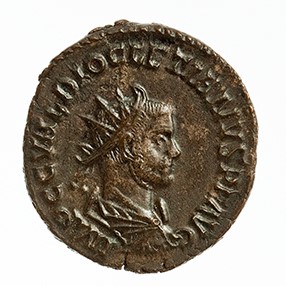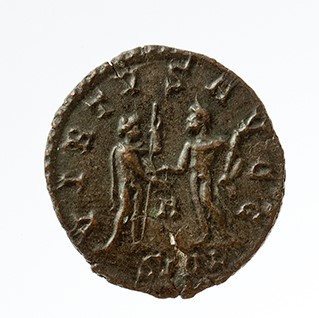Acquisition number: 1968.07
Obv.: Bust of Diocletian r., radiate, draped, cuirassed, bearded. IMP(erator) C(aesar) C(aius) VAL(erius) DIOCLETIANVS P(ius) F(elix) AVG(ustus).
Rev.: Jupiter standing r., naked except for cloak on shoulders, with sceptre in left hand and thunderbolt in right, facing Hercules standing l., naked, holding lionskin and club in left hand, right hand outstretched. VIRTVS AVGG(= Augustorum). In exergue, A, underneath, SML.
Title: Antoninianus of Diocletian - 1968.07
Acquisition number: 1968.07
Author or editor: Beryl Rawson
Culture or period: Roman Imperial
Date: AD 287-288?
Material: Metal - Copper-silver alloy
Object type: Coins - Roman
Dimensions: 20mm (w)
Origin region or location: France
Origin city: Lugdunum
Display case or on loan: 7
Keywords: Coin, antoninianus, Roman, Imperial, Diocletian, Jupiter, Hercules, Lugdunum, Roman Gaul
Sear, D.R., Roman Coins and their Values 5 vols (London, Spink, 2000-2014) 12720; Mattingly, H., E.A. Sydenham, C.H. Sutherland, R.A. Carson, The Roman Imperial Coinage 13 vols (London, Spink, 1923-1994) V, part 2 p. 229 no. 93.
1968.07
Antoninianus of Diocletian
3.044 g. AD 287-288?
Obv.: Bust of Diocletian r., radiate, draped, cuirassed, bearded. IMP(erator) C(aesar) C(aius) VAL(erius) DIOCLETIANVS P(ius) F(elix) AVG(ustus).
Rev.: Jupiter standing r., naked except for cloak on shoulders, with sceptre in left hand and thunderbolt in right, facing Hercules standing l., naked, holding lionskin and club in left hand, right hand outstretched. VIRTVS AVGG(= Augustorum). In exergue, A, underneath, SML.
Diocletian was acclaimed emperor by the army in the East in AD 284 and replaced Carinus in 285. In AD 286 he made Maximianus fellow Augustus. Diocletian was identified with Jupiter, Maximian with Hercules. The reverse proclaims the ‘virtue/valour of the (two) Augusti’.
The mint-mark indicates that the coin was struck at Lugdunum (Lyon). The A identifies the workshop which produced the coin.
The antoninianus, originally a silver coin, now consists entirely of base metal. The gradual deterioration can be traced through the third century. About AD 294 Diocletian put an end to this state of affairs by completely reforming the coinage and a new small silver coin, the follis, was introduced. As David Sear puts it ‘a radical departure from previous practice was the reintroduction of pure silver in the form of the argenteus’. These smallish silver coins are sometimes called siliquae. (See Sear volume IV p 78, John Melville Jones, A Dictionary of Ancient Roman Coins, Seaby, 1990, pp 24 & 289 for further discussion of silver coin denominations and Diocletian’s currency reforms).
Sear, D.R., Roman Coins and their Values 5 vols (London, Spink, 2000-2014) 12720; Mattingly, H., E.A. Sydenham, C.H. Sutherland, R.A. Carson, The Roman Imperial Coinage 13 vols (London, Spink, 1923-1994) V, part 2 p. 229 no. 93.

